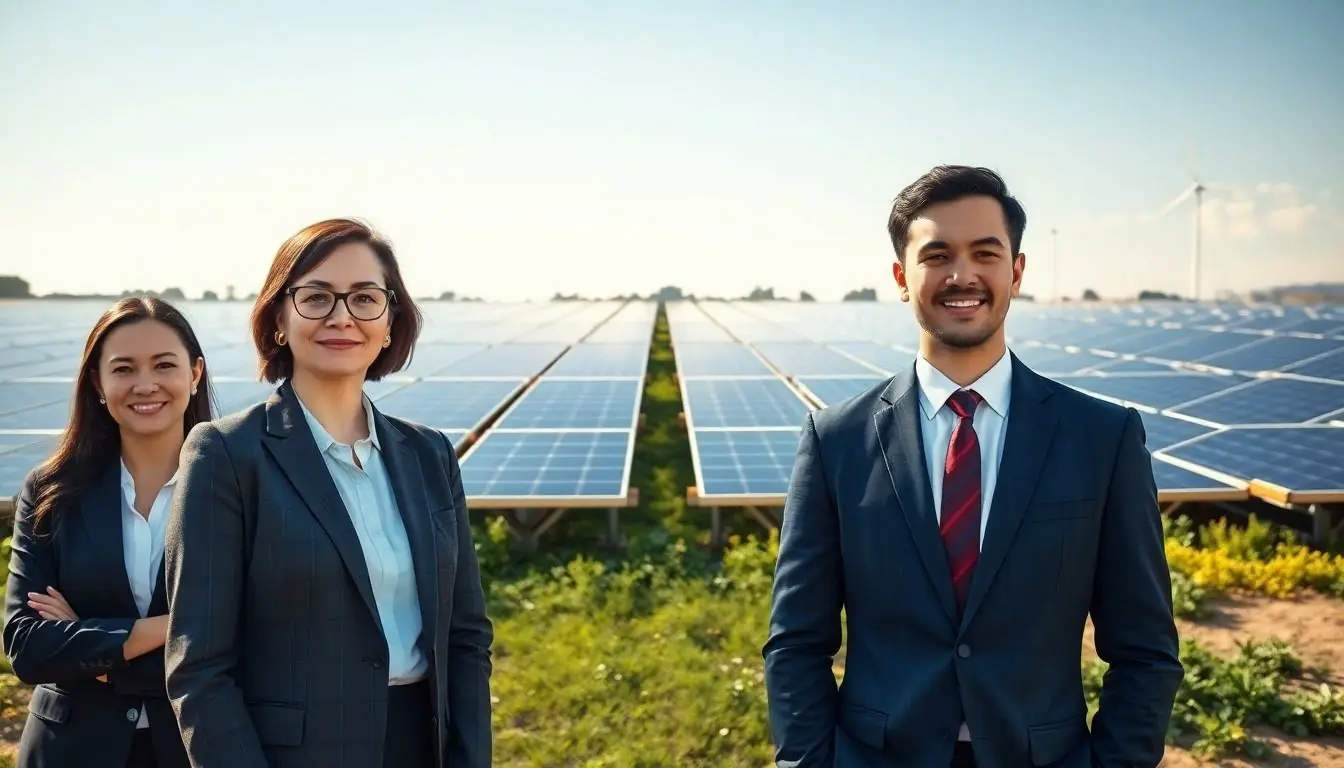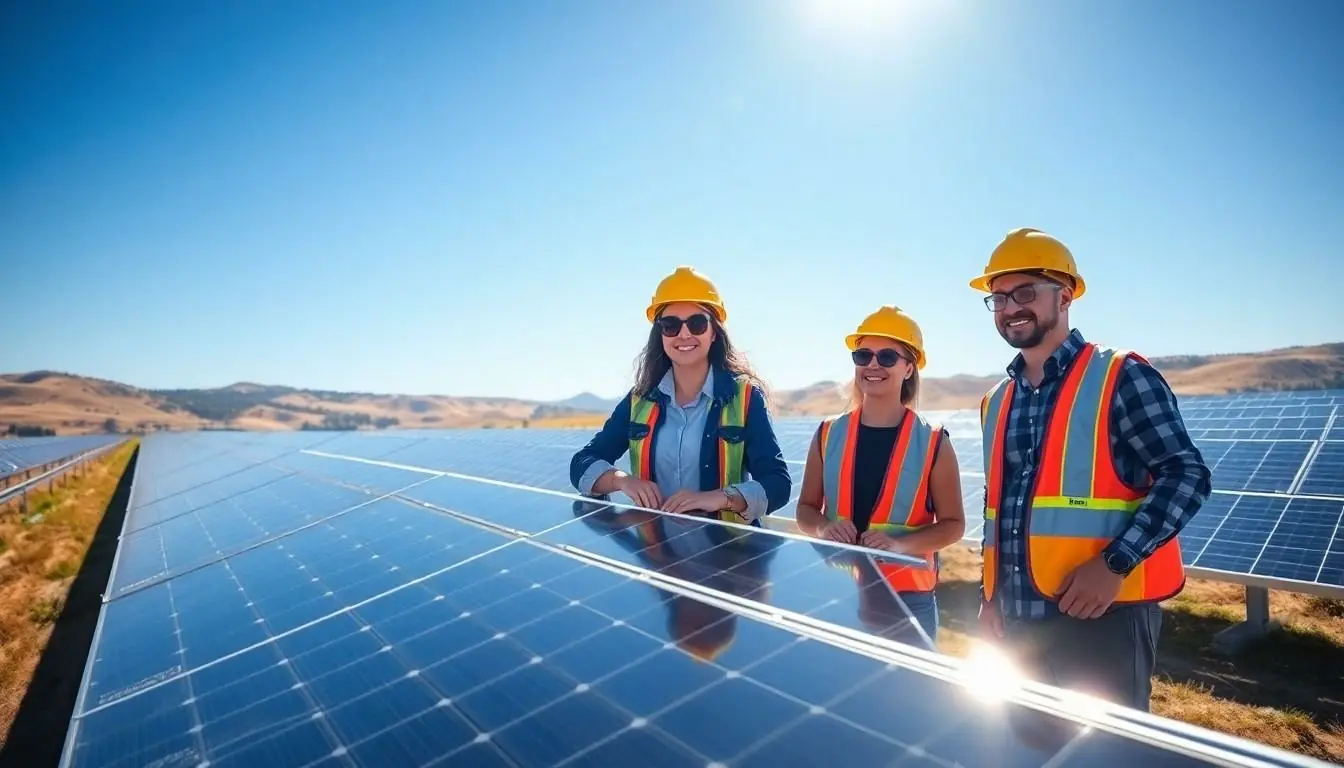In a world where fossil fuels are starting to feel like that old pair of shoes nobody wants to wear anymore, renewable energy companies are stepping up to the plate like eco-warriors in capes. These innovators are not just saving the planet; they’re also making green energy as cool as a summer breeze. From solar power to wind farms, they’re transforming the way America powers its homes and businesses.
Table of Contents
ToggleOverview of Renewable Energy in the USA
The renewable energy landscape in the USA has expanded significantly in recent years. Innovations in solar power and wind farms contribute to this growth, providing cleaner alternatives to fossil fuels. By utilizing energy sources like solar, wind, hydro, and geothermal, the industry promotes sustainability.
In 2022, renewable energy accounted for approximately 20% of total U.S. electricity generation. Wind energy produced 10% of this total, while solar energy contributed around 4%. Rapid advancements in technology have increased efficiency, making renewable energy more competitive in pricing compared to traditional energy sources.
Investments in the renewable sector have surged, with over $55 billion allocated in 2021 alone. Many companies are emerging as leaders in this field, driving the transition toward sustainable energy solutions. Notably, the Biden administration has set ambitious goals. By 2035, the aim is to achieve a carbon-free power sector.
Several states lead the way in renewable energy adoption. California, Texas, and New York consistently rank among the highest in solar and wind energy capacity. Policies such as tax incentives and renewable energy standards encourage further development.
Communities are reaping the benefits of renewable energy. Jobs in this sector are on the rise, with over 250,000 workers employed in solar energy alone. The shift toward clean energy also enhances energy security, reducing dependence on imported fossil fuels.
Collectively, these elements illustrate a vibrant future for renewable energy in the USA. Companies dedicated to innovation are crucial in this transition, shaping a more sustainable energy landscape for all.
Key Factors for Evaluating Companies

Evaluating renewable energy companies requires careful consideration of several factors that indicate their market presence and innovation capacity.
Market Share and Growth Potential
Market share reflects a company’s influence within the renewable energy sector. Companies leading in market share demonstrate strong positioning and consumer trust. In 2022, renewable energy generated approximately 20% of U.S. electricity. Companies that capture significant portions of this market are poised for growth. Additionally, analyzing growth potential involves reviewing projected expansion rates. With over $55 billion invested in the sector in 2021, an upward trend in investment indicates companies that are strategically aligned with market needs. As the Biden administration sets goals for a carbon-free power sector by 2035, companies focused on sustainable practices enjoy a favorable outlook.
Technological Innovation
Technological innovation serves as a cornerstone for the success of renewable energy companies. Companies that prioritize advancements are more likely to enhance efficiency and reduce costs. Rapid improvements in solar and wind technologies have contributed to increased competitiveness against traditional energy sources. For instance, innovations allow for higher energy yields from solar panels and greater capacity in wind turbines. Companies leading in technological research and development push boundaries, thereby driving industry standards. Investing in new technologies means not only adapting to current demands but also preparing for future energy needs, ensuring long-term viability in a dynamic sector.
Leading Renewable Energy Companies
Various companies stand at the forefront of renewable energy in the USA, contributing to its sustainable future. NextEra Energy leads as the largest generator of wind and solar energy, focusing heavily on innovation and sustainability. Pacific Gas and Electric operates in California, investing in renewable resources to enhance energy security for its customers.
Next, Enphase Energy specializes in solar technology, particularly in microinverters, helping to optimize solar energy use in residential settings. Sunrun ranks among the biggest solar energy providers, offering comprehensive solutions for both installation and financing. The firm emphasizes community empowerment through accessible solar energy.
Among other notable players, First Solar stands out for its advanced solar panel manufacturing, prioritizing sustainability and efficiency. Duke Energy also invests significantly in renewables, integrating solar and wind generation within its service areas in the southeastern USA.
According to the latest data, in 2022, renewable energy accounted for roughly 20% of total U.S. electricity generation. Companies like NextEra Energy and Pacific Gas and Electric are instrumental in this shift, enhancing the market share and growth potential for clean energy solutions.
With over $55 billion invested in renewables in 2021, these companies exemplify a robust commitment to transforming the energy landscape. Further, states such as California and Texas lead the pack, driven by strong policies and incentives.
This dynamic market showcases the potential for innovation, sustainability, and job creation in the renewable sector. Each company’s focus on technological advancements ensures competitiveness and continued growth, pivotal for the future of energy in the USA.
Company Profiles
Several leading companies are paving the way in renewable energy across the USA. These organizations drive innovation, sustainability, and growth, significantly impacting the energy sector.
Company A: Overview and Achievements
NextEra Energy stands as a leader in renewable energy generation. With approximately 28,000 megawatts of solar and wind capacity, it ranks as the largest generator of wind and solar power in the world. Over the past five years, NextEra has consistently focused on clean energy investments, targeting a 20% increase in renewable generation. Their commitment to sustainability has also earned them a position among the world’s most admired companies by Fortune magazine.
Company B: Overview and Achievements
Pacific Gas and Electric (PG&E) plays a crucial role in delivering energy to California. By investing in solar, wind, and energy efficiency programs, PG&E aims to achieve a carbon-free energy future by 2045. The company has made significant strides toward meeting its renewable energy procurement goals, reaching 33% by 2020. Furthermore, PG&E emphasizes enhancing energy security and reliability for its customers while reducing greenhouse gas emissions.
Company C: Overview and Achievements
Enphase Energy is known for its innovative solar technology solutions. The company specializes in microinverters, energy management systems, and battery storage. Contributing to a growing market, Enphase has seen strong revenue growth, with 2022 revenues exceeding $1 billion. Their commitment to quality and efficiency has positioned them as a prominent player in the renewable sector, making solar energy accessible to more households and businesses across the country.
Future Trends in Renewable Energy
Innovations in renewable energy technology are set to redefine the sector. Expectations indicate that solar and wind energy efficiency improvements will drive down costs further, making adoption more widespread. Market demand for clean energy continues to grow, with projections showing significant increases in capacity over the next decade.
Investment trends reflect a robust commitment to renewable technologies, with funding expected to exceed $100 billion annually by 2030. Forecasts show that solar capacity alone could reach over 600 gigawatts in the United States, underscoring the urgency for companies to innovate. Companies that embrace advancements in battery storage solutions will likely gain a competitive edge.
State policies play an integral role in the growth of renewable energy. For instance, California has ambitious goals for 100% clean energy by 2045, further encouraging investment and innovation. Texas leads in wind energy production, showcasing the viability of localized resource development.
Public and private partnerships are emerging as vital contributors to renewable energy projects. Collaboration between universities, startups, and established firms is fostering a culture of innovation, quickly translating research into actionable solutions. Expectations around job creation in these sectors are similarly optimistic, with the industry projected to employ over 700,000 workers by 2030.
Regulatory support and subsidies will continue to facilitate expansion. As companies like NextEra Energy and Enphase Energy lead the charge, they reinforce the strategy that a shift toward sustainability equates to economic opportunity. Consequently, a vibrant future rests on the capability of these innovative firms to adapt and survive in a rapidly evolving market.
The renewable energy sector in the USA is witnessing a remarkable transformation driven by innovative companies committed to sustainability. As the nation moves toward cleaner energy sources the impact of these companies is evident in both environmental benefits and economic opportunities. With advancements in technology and increasing investments the future looks bright for renewable energy.
States leading the charge are creating a supportive environment that fosters growth and job creation. The commitment of companies like NextEra Energy and Enphase Energy showcases the potential for a sustainable energy landscape. As the industry evolves it’s clear that these eco-warriors will play a pivotal role in shaping a greener future for America.




